Another 3 Minute Theory! Suzanne Newcombe discusses Karl Popper’s “Conjectures and Refutations”, and explains what it has to do with functional and substantive definitions of religion.
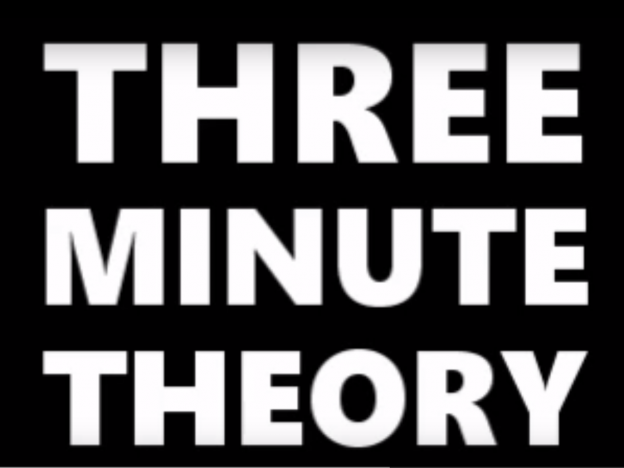


Another 3 Minute Theory! Suzanne Newcombe discusses Karl Popper’s “Conjectures and Refutations”, and explains what it has to do with functional and substantive definitions of religion.
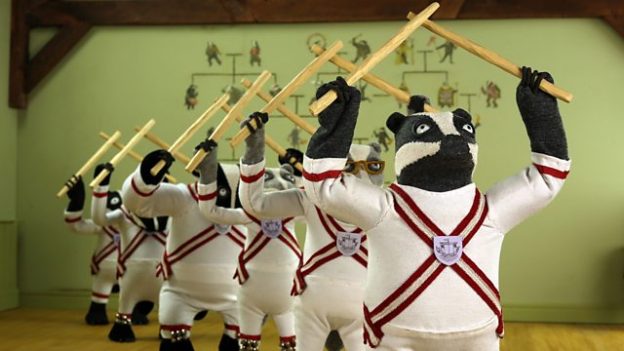
By Chloe Middleton-Metcalfe, University of Roehampton
The BBC’s featured online animation for December 2018, Quarantine, is described as: ‘A post-Brexit pagan dance fantasy about a troupe of Morris-dancing badgers’ (BBC online). Quarantine builds upon a culturally pervasive idea that has been widely discredited by researchers – that folk dance has its origins in pre-Christian ritual. However documentary research has failed to provided an easily digestible alternative, tentatively suggesting some connection with the end of the Muslim-Christian wars in the Iberian Peninsula in the 15th century (Forrest 1999). With a raft of publications dating back to 1912 espousing the ritual theory, it is easy for interested individuals to be led down the pre-Christian garden path. Indeed, the ancient origins explanation probably does provide a more palatable alternative for many liberally inclined folk dance supporters than much of the historical documentation. For example, the practice of applying black face paint for ‘border’ morris was linked to anonymity and ritual, but research points to stronger links with stage minstrelsy (Metcalfe 2013). But where did the idea of ancient ritual come from in the first place?
In 1871 anthropologist Edward Burnett Tylor (1832-1917) published Primitive Culture, in which he laid out his theory of cultural survivals. Tylor posited that folklore or superstitions were ‘survivals’ of an earlier culture which had evolved leaving traces of itself behind in customs which could be seen as being cultural fossils (Hodgen 1931, Tremlett et.al. 2017). Tylor’s ideas were influenced by cultural evolutionism and drew parallels between the folklore of western civilised Europe and the culture of contemporary so-called ‘primitive’ societies, which were both inaccurate and racist (Kuper 1991, Bennett 1994). Tylor’s work was very influential as his ideas shaped James Frazer’s (1851-1941) publication The Golden Bough: A Study in Comparative Religion (1890). Frazer pieced together diverse accounts of cultural practices from around the world to argue for a universal primeval religion, of which contemporary folklore practices were the surviving fragments (Hutton 2001: 112-131). The Doctrine of Survivals became the standard explanation for most folklore, including dance (Cawte 1993).
Frazer’s theories were picked up and promoted by Cecil Sharp (1859-1924), founder of the English Folk Dance Society. As dance historian Buckland has noted (1982), between the first and second editions of the The Morris Book Sharp changed his theoretical positioning on the origins of the dance form from one which postulated the arrival of the dance in England during the reign of Edward III (1312-1377), to a theory which considered morris dancing to be ‘one of the seasonal pagan observances prevalent amongst primitive communities’ (1912: 11). Sharp had gone Frazarian. Even country dancing was linked back to ancient ritual practice with maypoles providing an imaginative link between the older form of the dance and its modern manifestations (Sharp and Oppé 1924: 6, Judge 1979 [2000]: 85).
Theories on the origins of dance more generally were also influenced by the Doctrine of Survivals. In 1895 Lilly Grove published Dancing an early history on the subject in which even the most secular forms of dance are characterised as having their roots in ‘a form of worship, or at least a form of magic’ (Grove 1895:7). Grove was perhaps unduly influenced by the Golden Bough as she later married James Frazer, but even without the family connection, many early twentieth century theories of dance were linked to the Doctrine of Survivals and an associated evolutionary-based approach to the study of culture (Buckland 2014). Influential dance historian Curt Sachs, whose ideas like Tylor’s and Frazer’s were to receive heavy criticism (Youngermann 1974), postulated that: ‘The dances of man are never mere pastimes, or artistic performances without significance; they are magic actions and in consequence constructed in such a manner as to achieve a magic purpose.’ (Sachs 1931: 30). Theories and definitions of dance emphasised the non-verbal and so dance was particularly vulnerable to discussion of animalistic instinct and primitive ritual. Indeed, popular dance histories often supplied a problematic evolutionary-based framework for the reader, who would pass through chapters of tribal and western folk dance to reach the acme of developed western theatrical dance culture – ballet (Grau 1993/4).
Whilst the contemporary dance world has successfully distanced itself from such ritualistic narratives by emphasising the role of the individual creative genius, the same cannot be said for English folk dancers. The Doctrine of Survivals and The Golden Bough continue to circulate under a number of guises (Buckland 2001/2). The 1973 cult film The Wicker Man, which drew upon The Golden Bough for inspiration did much to indirectly bring Frazer’s work to new audiences (Koven 2007, Trubshaw 2002, Scovell 2017). Arguably the most fruitful investigation of the link between morris and ritual dance would be in its current usages and understandings. Indeed, the link between folklore and non-Christian faith is a reality for some contemporary Pagans, for whom appreciation of, or engagement in, folk music and dance is a part of their religiosity (Chase 2006, Letcher 2014).

Graham Harvey, Hugh Beattie & Suzanne Newcombe are talking at the Understanding Religion Through Objects study day at the British Museum, Sat 29 Jan. They use Museum objects to explore the rituals and everyday lives of religious practitioners.
Talks focus on themes such as initiation, pilgrimage, sacrifice and worship, and Venetia Porter, curator of the Albukhary Foundation Gallery of the Islamic world, will also discuss the re-presenting of objects and art from the cultures of Islam.
Booking and full details at https://tinyurl.com/ybx33asa
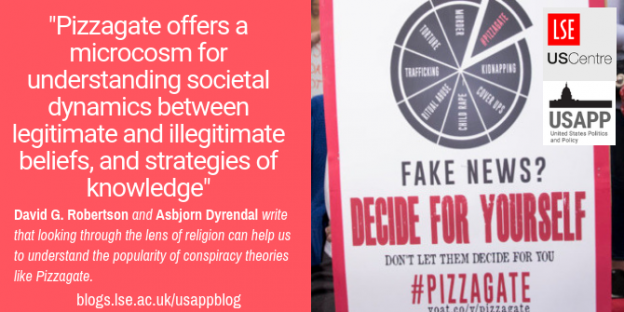
David G. Robertson has a new piece out over at the LSE’s blog on United States Policy and Politics blog, discussing his work on the intersections of religion and conspiracy theories. Read the whole thing here.
Conspiracy theories rarely lead to violence; with the main exception being 2016’s Pizzagate which culminated in a gunman threatening a pizza restaurant which he believed was a front for a satanic paedophile ring. David G. Robertson and Asbjorn Dyrendal unpack some of the reasons why conspiracy theories such as Pizzagate can gain ground so rapidly, citing links to the “satanic panic” of the 1990s. They also point to links with wider apocalyptic narratives of right-wing conspiracist groups, narratives which are often also reflected in religion.
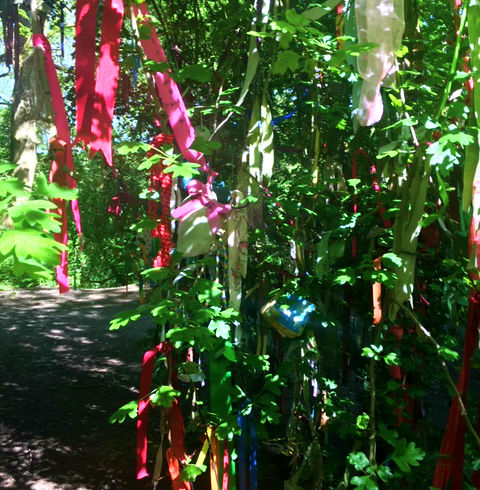
By Kate Smith, University of Hull
The water we meet in the landscape carves out many meanings: it is sustenance, beauty, leisure, boundary, edge, life, death, rebirth. In my own landscape, it is a thing of contradictions. In my landscape there is only one river, yet we are surrounded by water; the valleys are dry, yet green and abundant; stubborn, marshy carr is locked in perpetual battle with just as stubborn, drain-building men; great chunks of old land fall away and new land emerges from the silt. It is a place where the difficulty of watering cattle and crops is given painful counterpoint by the frequency of flooding. All of this, these meanings, battles and paradoxes are ruled by the complex relationship between rocks, soil, water and people.
The meaning I am most drawn to, that resonates the most as the seasons around me change and the soil hardens with frost, is ‘rebirth’.
I spent a painful decade after getting my PhD, wandering around looking for something else to do: my doctoral research was intimately linked to the landscapes of my childhood, but after seven years of research, a major relocation and two babies, that connection had been lost. I hadn’t realised the extent to which the landscapes of my imagination fed my research until I was in a landscape with which I had no connection at all. My folklorist-research brain hibernated: I tried and tried to find a way to engage with the hills and plains that I was now living in but the spark would not reignite. And so I carried on with the rest of life, busy with small people and all that they demand. I almost forgot that once I had imagined, created and thought so intensely that it felt as though my head was full of dancing fireflies.
And then one day, a New Year’s day, we went for a walk. Just a couple of hours, but I wanted to go somewhere away from our usual paths so we headed off a few miles away to explore a circular route which included a bit of the old railway that once connected York and Beverley. And there, alongside the trackbed, looking somewhat out of place among the wintry trees and dark mud was a large, heavily decorated Rag Tree.
My folklorist-researcher brain woke up.
Next to the tree was a noticeboard, explaining the history of the site. Behind the noticeboard, off to the right were a series of steps and terraces, and a large, coffin-shaped tank into which flowed the clear, bright water of St Helen’s Well.
My folklorist-researcher brain *really* woke up.
Although it was cold, and although my dear, patient husband was somewhat bemused by my sudden excitement, we stayed by that well and its rag tree for nearly an hour as I wandered about, trying to photograph everything, trying to count and categorise all the rags in the tree, trying to photograph all the panels in the noticeboard, trying to swallow all of the context in one giant gulp.
I had found my way in. I had found meaning in a landscape that had, until now, been alien and disinterested.
My work in this place had to be about the water. This landscape is all about the water, and the way that people live with it. The folklorist-researcher brain that had slept and slept for so long finally had something to stay awake for. That walk was the start of an exploration that continues: I now have a visiting research position within the Energy and Environment Institute at the University of Hull, working alongside geographers and geologists who are concerned with the physical effects of water and flooding. They know an awful lot about how water has affected the physical landscape of this area, but they know very little about how water has affected the emotional, cultural, and spiritual landscape of this area.
I think now that perhaps the prolonged hibernation of my thinking brain was a way of coping with the mundane relentlessness that parenting brings us. Getting back into academic work hasn’t been without its challenges, and I’m at the very start of my formal research into water in this landscape. But I have already learnt this much: it is never too late to have another go, and that sometimes a period of intellectual stillness can be a good thing. And I am grateful that my thinking, imagining, creating brain was reborn by an encounter with water in my landscape.
Lecturer in Religious Studies, David G. Robertson, is one of the editors of the just-published Handbook of Conspiracy Theory and Contemporary Religion, along with Asbjørn Dyrendal (NTNU, Norway) and Egil Asprem (Stockholm University).
Conspiracy theories are a ubiquitous feature of our times. The Handbook of Conspiracy Theories and Contemporary Religion is the first reference work to offer a comprehensive, transnational overview of this phenomenon along with in-depth discussions of how conspiracy theories relate to religion(s). Bringing together experts from a wide range of disciplines, from psychology and philosophy to political science and the history of religions, the book sets the standard for the interdisciplinary study of religion and conspiracy theories.
As well as David’s contributions, the book also includes a chapter co-written by Lecturer Suzanne Newcombe, entitled “Trust Me, You Can’t Trust Them”: Stigmatised Knowledge in Cults and Conspiracies.” Other chapters include methodological overviews from sociology, psychology and philosophy; regional case studies on Sri Lanka, Albania, Greece, Japan and elsewhere; thematic chapters on popular music, Esotericism, Church of the SubGenius, neo-Nazism, the Internet; and more.
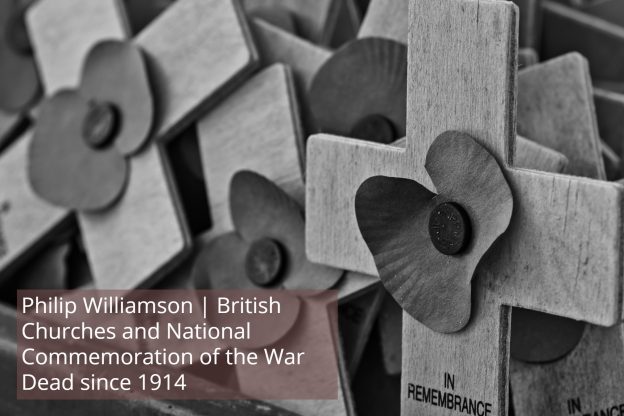
In case you missed it the first time, here’s Philip Williamson (Durham University) talking about Remembrance Day: the British Churches and National Commemoration of the War Dead since 1914, one of the keynote presentations from our Contemporary Religion in Historical Perspective conference, recorded Feb 21st 2018.
Most historical work on commemoration emphasises the civil creations from 1919 onwards: Armistice day, the two-minutes silence, the Cenotaph, the War Graves Commission and war memorials, and the British Legion. Aside from the burial of the Unknown Warrior, the churches are treated almost as adjuncts. Yet British church leaders had been involved with remembrance since 1914, and from 1919 they created their own religious commemoration of Remembrance day, which in 1946 replaced Armistice day as the official occasion for national commemoration. Against the supposed trends towards secularisation, the churches acquired and retain a leading part in remembrance of the war dead. Yet some tension always existed between the civil and religious commemorations, and what secured the place of the churches in national rituals also brought compromises. This paper will consider how the protestant churches created a new religious commemoration of the war dead; how remembrance contributed to co-operation between leaders of the various British churches; how the character of Remembrance has changed; and how in national commemoration the churches and the state arrived at an alliance of church religion and civil religion.
Photo by James Harris on Unsplash

By David G. Robertson
Were there always little makeshift shrines to dead people around the city?
I ask in all seriousness. I grew up in Inverness but ended up in Leith about fifteen years ago, and since then I have been fascinated by the makeshift memorials that I began to see popping up every few months. Like roadside shrines.
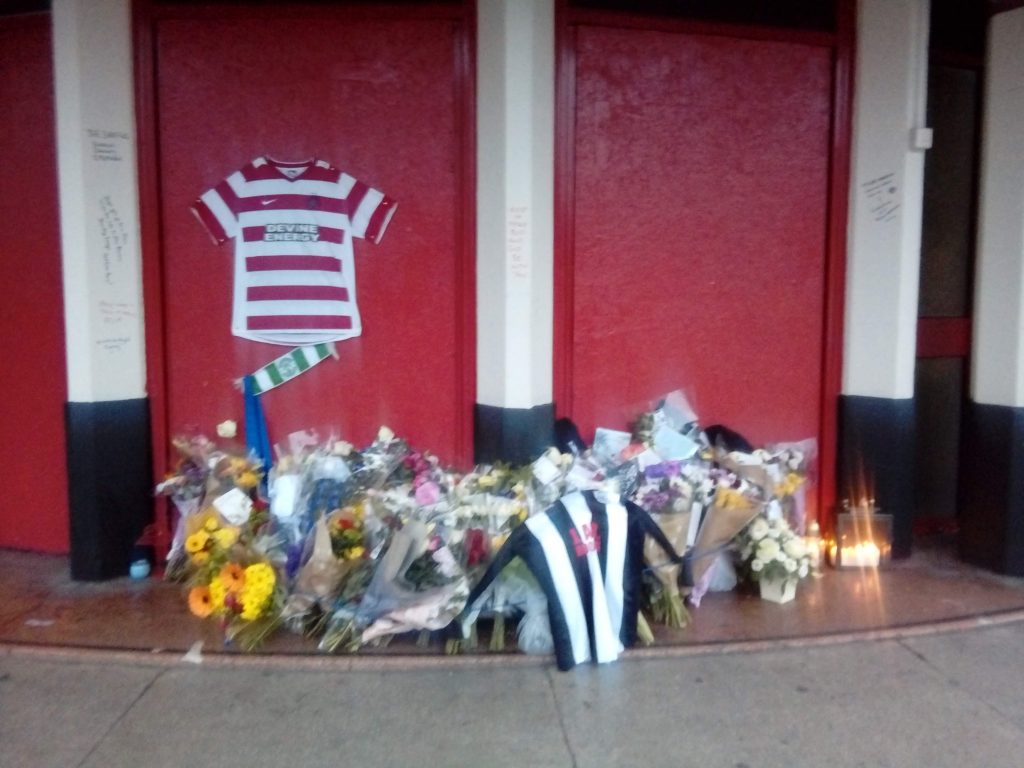 Usually they are for young who have died in unfortunate circumstances: a young man who was attacked late at night around New Year; where a child was hit by a car; where a heroin addict died after a fight outside Boots as they waited for their methadone prescription. There’s an unusual one on a cycle path rather than a pavement, but I’m not sure about the details there. It is interesting to note the similarities among the features, however: football colours are typical, as well as other hobbies, like music; flowers are always present, and candles. So while there is (usually) no explicitly religious content, there are recognizable funerary symbols.
Usually they are for young who have died in unfortunate circumstances: a young man who was attacked late at night around New Year; where a child was hit by a car; where a heroin addict died after a fight outside Boots as they waited for their methadone prescription. There’s an unusual one on a cycle path rather than a pavement, but I’m not sure about the details there. It is interesting to note the similarities among the features, however: football colours are typical, as well as other hobbies, like music; flowers are always present, and candles. So while there is (usually) no explicitly religious content, there are recognizable funerary symbols.
 Leith’s an interesting part of Edinburgh. For a long time it was very rundown, and when I moved to Edinburgh in the 1990s (around the time Trainspotting was released) it was still known as “The Heroin Capital of Europe”; now it has three different Michelin Starred restaurants and one of Britain’s top tourist attractions. So unlike, say, Morningside or Stockbridge, it’s not very middle-class – more a few rich people and then a BIG gap before you get down to folk like me. But Leith also has a Catholic heritage, even if most people don’t realise why Hibs fans are referred to as “Huns”. So maybe these kinds of spontaneous shrines were always something that happened in Leith, and I didn’t see them before because I was in Calvinist Inverness. I wonder, then, if they are common in Glasgow? [Update: Marion Bowman just shared a photo of one for a Big Issue seller in Bath).
Leith’s an interesting part of Edinburgh. For a long time it was very rundown, and when I moved to Edinburgh in the 1990s (around the time Trainspotting was released) it was still known as “The Heroin Capital of Europe”; now it has three different Michelin Starred restaurants and one of Britain’s top tourist attractions. So unlike, say, Morningside or Stockbridge, it’s not very middle-class – more a few rich people and then a BIG gap before you get down to folk like me. But Leith also has a Catholic heritage, even if most people don’t realise why Hibs fans are referred to as “Huns”. So maybe these kinds of spontaneous shrines were always something that happened in Leith, and I didn’t see them before because I was in Calvinist Inverness. I wonder, then, if they are common in Glasgow? [Update: Marion Bowman just shared a photo of one for a Big Issue seller in Bath).
 Or maybe they’re a recent phenomenon. Our Instagram feed has included several photos of padlocks appearing on fences in popular tourist spots, and in the last few years the practice of rubbing the toe of the statue of John Knox on the Royal Mile has gone from something specific to philosophy graduates to all tourists, and has now spread to Greyfriar’s Bobby’s nose, 100 yards along George IV Bridge. These rituals are certainly changing over a relatively short period of time, although a serious dive into the broader sociological reasons why would require more space than a blog post would allow. But it is certainly interesting to speculate on these shrines being members of the public reclaiming what had traditionally been a function of religious institutions in a post-Christian Scotland.
Or maybe they’re a recent phenomenon. Our Instagram feed has included several photos of padlocks appearing on fences in popular tourist spots, and in the last few years the practice of rubbing the toe of the statue of John Knox on the Royal Mile has gone from something specific to philosophy graduates to all tourists, and has now spread to Greyfriar’s Bobby’s nose, 100 yards along George IV Bridge. These rituals are certainly changing over a relatively short period of time, although a serious dive into the broader sociological reasons why would require more space than a blog post would allow. But it is certainly interesting to speculate on these shrines being members of the public reclaiming what had traditionally been a function of religious institutions in a post-Christian Scotland.
Instead, I want to end on a point about how we read data for change. To assume that such change was a new phenomenon would be an error, if I didn’t have data from the period before. Just as it would be wrong to assume that sexual fetishes only began with the Kinsey Report, to assume that popular religious practices only started when scholars started to record them may be making the tail wag the dog. As I argued in a previous post, to assume that social behaviours are static and unchanging until the scholar casts their gaze upon it is rather colonial in itself, as though everything “primitive” (be that the colonies or the proles) never changed until it was forced on them. We see this much change and innovation in a few square miles over ten years – what would a history of any of the supposedly monolithic “World Religions” look like with this level of detail? How well would any of the claims to continuity, consistency and tradition hold up?
For Halloween, Prof Graham Harvey, Dr Stephanie Lay and Dr Alison Robertson chat about the past, present and future of the festival and of fear, from zombies to robots…
Courtesy of FASS on YouTube.